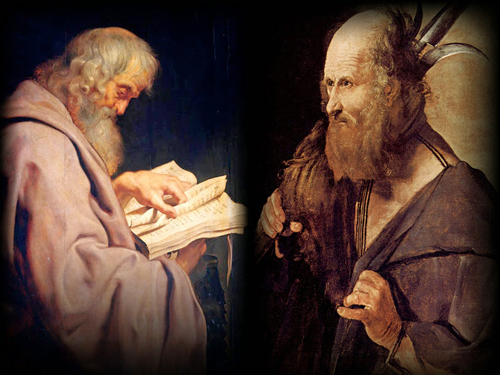
The Feast of St. Simon and St. Jude is celebrated on October 28th. The Church commemorates them together due to ancient Christian traditions and writings that suggest their collaboration in spreading the Gospel and a shared martyrdom in distant Persia. Their cooperation and shared mission continue to inspire and guide the Christian community, reminding us that great deeds can be accomplished by working together.
St. Simon the Zealot
St. Simon was a devoted disciple of Jesus (Matt. 10:4, Mk. 3:18, Lk. 6:15, Acts 1:13). He was distinguished from Simon Peter because he was called “The Zealot” by Luke or “The Canaanite” (Matthew, Mark). His epithet “Zealot” or “Zelotes” suggests that Simon may have belonged to the Zealot party. This ardent Jewish nationalist group resisted Roman occupation. While the Bible doesn’t explicitly confirm this connection, it underscores Simon’s passion and fervor for his beliefs and serving Christ with dedication. St. Simon the Zealot is one of the lesser-detailed apostles in the New Testament, and as such, much of his iconographic representation has been established by tradition. Art often depicts him with a saw due to his alleged martyrdom from being sawn in half.
St. Jude (Thaddeus)
St. Jude, also known as “Thaddaeus,” (Matthew, Mark) was another faithful disciple of Jesus (Matt. 10:3, Mk. 3:18, Lk. 6:16, Acts 1:13). Luke calls him “Judas ,son James”. He is not that Judas! He is specifically remembered for his inquiry into why Jesus revealed himself to only a select few rather than the entire world. This intriguing question, posed by St. Jude in John 14:22-24, reflects his contemplative nature. Catholics believe the Apostle Jude, who is referred to twice as “Jude, the brother of James” (Lk. 6:16, Acts 1:13) to be the same as the brother of St. James of Jerusalem and a relative of Jesus, who wrote the Epistle of Jude (Jude 1:1). Protestants differ on this, taking a more direct reading of James of Jerusalem and the Epistle of Jude’s author as brothers of Jesus (Matt.13:55, Mark 6:3) and, therefore, unable to be the same as the apostles.
Brothers in Apostleship
Both St. Simon and St. Jude were witnesses to significant moments in the life of Jesus and the early Christian community. They followed Jesus as he preached and ministered until his crucifixion, witnessed his resurrection, received his teachings during the 40 days post-resurrection, and were present at his ascension. Their enduring commitment led them to the upper room, where they joined fellow disciples in awaiting the promised Holy Spirit and became apostles of the Early Church.
Tradition holds that they ventured to distant Persia, where they fearlessly preached the Gospel. Their unwavering dedication to spreading the Good News ultimately led to their martyrdom. St. Simon’s and St. Jude’s relics are believed to be located in Saint Peter’s Basilica in Rome.
The Acts of St. Simon and St. Jude
The Acts of Simon and Jude is an apocryphal text that narrates the missionary journey of the apostles Simon the Zealot and Jude to the Persian Empire. Like many other apocryphal acts of the apostles, this text was written to provide a narrative about the later lives and missions of these apostles for whom the canonical scriptures offer limited information.
In this account, the apostles arrived in the ancient city of Babylon and began preaching the Gospel. Their endeavors, however, were not without resistance. The apostles encountered two powerful magicians, Zaroes and Arphaxat, who tried to oppose their missionary efforts with their magical abilities.
In response, Simon and Jude began performing a series of miracles that served as a resounding counterpoint to the magicians’ enchantments. These miracles, performed in the name of Jesus, served as a testament to the power of Jesus and validated their message in the eyes of the local population. Even influential figures within the Persian realm found themselves drawn to the Christian faith, leading to a profound wave of conversions. After many successful conversions and establishing Christian communities, both apostles met their death as martyrs for their faith.


 Twenty Third Sunday after Pentecost, Oct. 27
Twenty Third Sunday after Pentecost, Oct. 27